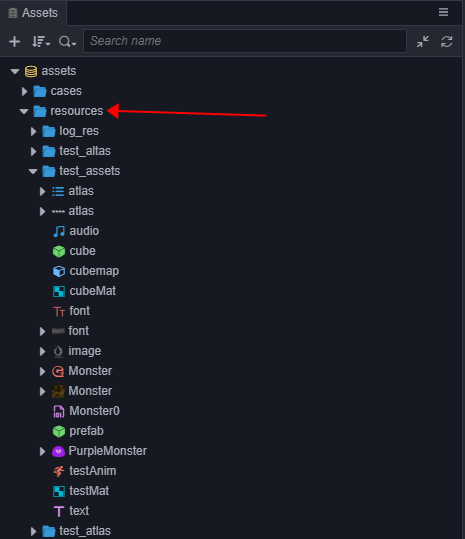加载资源
动态加载 resources
通常我们会把项目中需要动态加载的资源放在 resources 目录下,配合 resources.load 等接口动态加载。你只要传入相对 resources 的路径即可,并且路径的结尾处 不能 包含文件扩展名。
// 加载 Prefab
resources.load("test_assets/prefab", Prefab, (err, prefab) => {
const newNode = instantiate(prefab);
this.node.addChild(newNode);
});
// 加载 AnimationClip
resources.load("test_assets/testAnim", AnimationClip, (err, clip) => {
this.node.getComponent(Animation).addClip(clip, "anim");
});所有需要通过脚本动态加载的资源,都必须放置在
resources文件夹或它的子文件夹下。resources文件夹需要在 assets 根目录 下手动创建。如下所示:
resources 文件夹中的资源,可以引用文件夹外部的其它资源,同样也可以被外部场景或资源所引用。项目构建时,除了在 构建发布 面板中勾选的场景外,resources 文件夹中的所有资源,包括它们关联依赖的 resources 文件夹外部的资源,都会被导出。
如果一份资源仅仅是被 resources 中的其它资源所依赖,而不需要直接被
resources.load调用,那么 请不要 放在 resources 文件夹中。否则会增大config.json的大小,并且项目中无用的资源,将无法在构建的过程中自动剔除。同时在构建过程中,JSON 的自动合并策略也将受到影响,无法尽可能合并零碎的 JSON。注意:从 v2.4 开始,
loader等接口不再建议使用,请使用最新的assetManager相关接口,升级文档请参考 资源加载升级指南。
加载 SpriteFrame 或 Texture2D
图片设置为 sprite-frame 或 texture 或其他图片类型后,将会在 资源管理器 中生成一个对应类型的资源。但如果直接加载 test_assets/image,得到的类型将会是 ImageAsset。你必须指定路径到具体的子资源,才能加载到图片生成的 SpriteFrame:
// 加载 SpriteFrame,image 是 ImageAsset,spriteFrame 是 image/spriteFrame,texture 是 image/texture
resources.load("test_assets/image/spriteFrame", SpriteFrame, (err, spriteFrame) => {
this.node.getComponent(Sprite).spriteFrame = spriteFrame;
});// 加载 texture
resources.load("test_assets/image/texture", Texture2D, (err: any, texture: Texture2D) => {
const spriteFrame = new SpriteFrame();
spriteFrame.texture = texture;
this.node.getComponent(Sprite).spriteFrame = spriteFrame;
});如果指定了类型参数,就会在路径下查找指定类型的资源。当你在同一个路径下同时包含了多个重名资源(例如同时包含 player.clip 和 player.psd)就需要声明类型。当你需要获取 “子资源”(例如获取 ImageAsset 的子资源 SpriteFrame),就需要指定子资源的路径。
加载图集中的 SpriteFrame
对从 TexturePacker 等第三方工具导入的图集而言,如果要加载其中的 SpriteFrame,则只能先加载图集,再获取其中的 SpriteFrame。这是一种特殊情况。
// 加载 SpriteAtlas(图集),并且获取其中的一个 SpriteFrame
// 注意 atlas 资源文件(plist)通常会和一个同名的图片文件(png)放在一个目录下, 所以需要在第二个参数指定资源类型
resources.load("test_assets/sheep", SpriteAtlas, (err, atlas) => {
const frame = atlas.getSpriteFrame('sheep_down_0');
sprite.spriteFrame = frame;
});加载 FBX 或 glTF 模型中的资源
在将 FBX 模型或 glTF 模型导入编辑器后,会解析出该模型中包含的相关资源如网格,材质,骨骼,动画等,如下图所示:

你可以在运行时动态加载模型中的单一资源,只需指定到某个具体子资源的路径即可,如下所示:
// 加载模型中的网格资源
resources.load("Monster/monster", Mesh, (err, mesh) => {
this.node.getComponent(MeshRenderer).mesh = mesh;
});
// 加载模型中的材质资源
resources.load("Monster/monster-effect", Material, (err, material) => {
this.node.getComponent(MeshRenderer).material = material;
});
// 加载模型中的骨骼
resources.load("Monster/Armature", Skeleton, (err, skeleton) => {
this.node.getComponent(SkinnedMeshRenderer).skeleton = skeleton;
});资源批量加载
resources.loadDir 可以加载相同路径下的多个资源:
// 加载 test_assets 目录下所有资源
resources.loadDir("test_assets", function (err, assets) {
// ...
});
// 加载 test_assets 目录下所有 SpriteFrame,并且获取它们的路径
resources.loadDir("test_assets", SpriteFrame, function (err, assets) {
// ...
});预加载资源
从 v2.4 开始,除了场景能够预加载之外,其他资源也可以预加载。预加载的加载参数与正常加载时一样,不过预加载只会去下载必要的资源,并不会进行资源的反序列化和初始化工作,所以性能消耗更小,适合游戏运行中使用。
resources 提供了 preload 和 preloadDir 用于预加载资源。
resources.preload('test_assets/image/spriteFrame', SpriteFrame);
// wait for while
resources.load('test_assets/image/spriteFrame', SpriteFrame, (err, spriteFrame) => {
this.node.getComponent(Sprite).spriteFrame = spriteFrame;
});开发者可以使用预加载相关接口提前加载资源,不需要等到预加载结束即可使用正常加载接口进行加载,正常加载接口会直接复用预加载过程中已经下载好的内容,缩短加载时间。
关于预加载的说明,请参考 预加载与加载。
加载远程资源和设备资源
在目前的 Cocos Creator 中,我们支持加载远程贴图资源,这对于加载用户头像等需要向服务器请求的贴图很友好,需要注意的是,这需要开发者直接调用 assetManager.loadRemote 方法。同时,如果开发者用其他方式下载了资源到本地设备存储中,也需要用同样的 API 来加载,上文中的 resources.load 等 API 只适用于应用包内的资源和热更新的本地资源。下面是这个 API 的用法:
// 远程 url 带图片后缀名
let remoteUrl = "http://unknown.org/someres.png";
assetManager.loadRemote<ImageAsset>(remoteUrl, function (err, imageAsset) {
const spriteFrame = new SpriteFrame();
const texture = new Texture2D();
texture.image = imageAsset;
spriteFrame.texture = texture;
// ...
});
// 远程 url 不带图片后缀名,此时必须指定远程图片文件的类型
remoteUrl = "http://unknown.org/emoji?id=124982374";
assetManager.loadRemote<ImageAsset>(remoteUrl, {ext: '.png'}, function (err, imageAsset) {
const spriteFrame = new SpriteFrame();
const texture = new Texture2D();
texture.image = imageAsset;
spriteFrame.texture = texture;
// ...
});
// 用绝对路径加载设备存储内的资源,比如相册
const absolutePath = "/dara/data/some/path/to/image.png";
assetManager.loadRemote<ImageAsset>(absolutePath, function (err, imageAsset) {
const spriteFrame = new SpriteFrame();
const texture = new Texture2D();
texture.image = imageAsset;
spriteFrame.texture = texture;
// ...
});
// 远程音频
remoteUrl = "http://unknown.org/sound.mp3";
assetManager.loadRemote(remoteUrl, function (err, audioClip) {
// play audio clip
});
// 远程文本
remoteUrl = "http://unknown.org/skill.txt";
assetManager.loadRemote(remoteUrl, function (err, textAsset) {
// use string to do something
});目前的此类手动资源加载还有一些限制,对开发者影响比较大的是:
- 这种加载方式只支持图片、声音、文本等原生资源类型,不支持 SpriteFrame、SpriteAtlas、TiledMap 等资源的直接加载和解析。(如需远程加载所有资源,可使用 Asset Bundle)
- Web 端的远程加载受到浏览器的 CORS 跨域策略限制,如果对方服务器禁止跨域访问,那么会加载失败,而且由于 WebGL 安全策略的限制,即便对方服务器允许 http 请求成功之后也无法渲染。